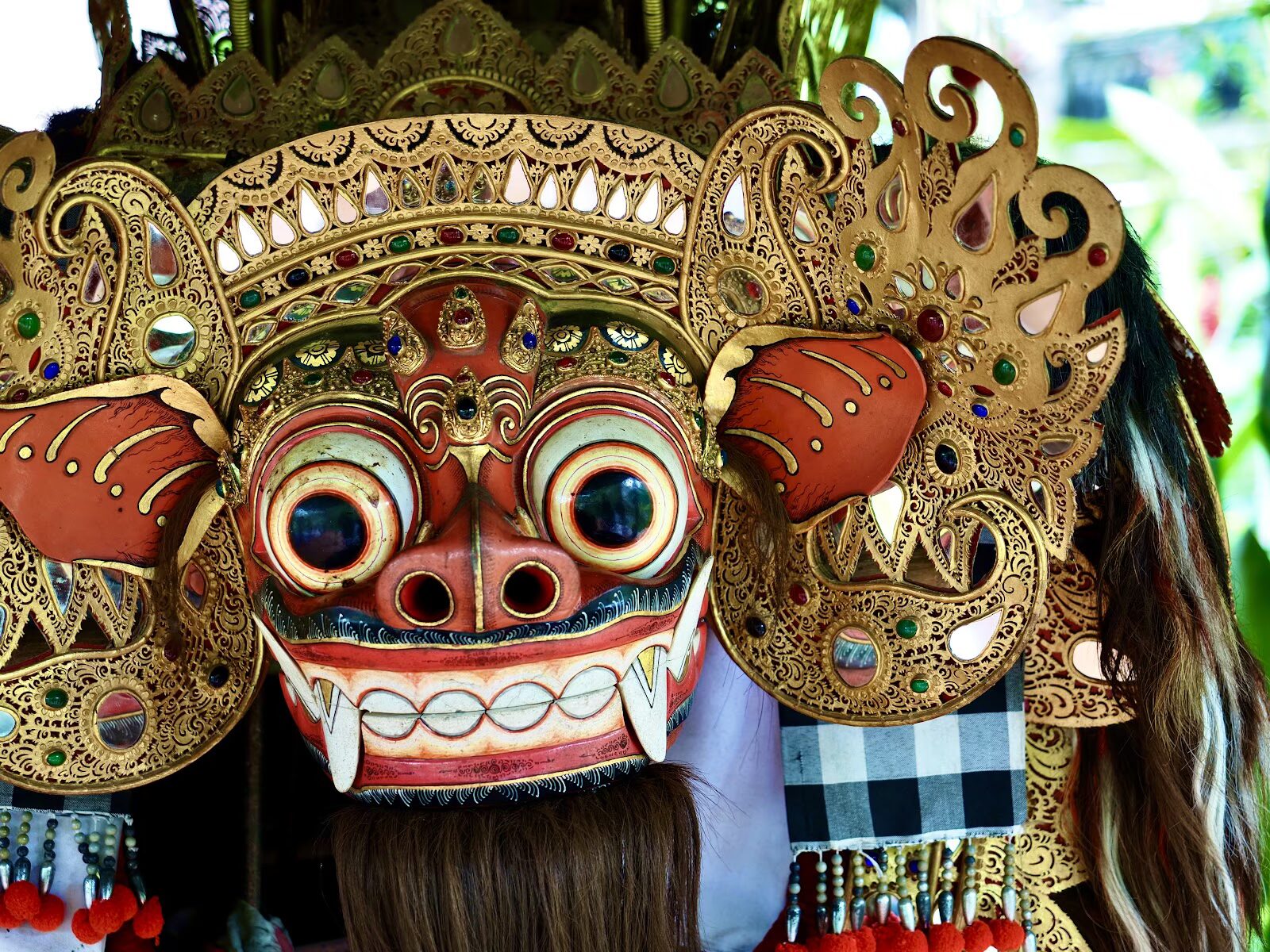Bali: Our Final Recap
Fri Aug 08 2025
|Conor and AlinaAs you might know from our most recent blog post, we had mixed feelings about our time in Bali. Nonetheless, arriving here evoked excitement and curiosity. For both of us, this was our first time in Southeast Asia —and it marked roughly the halfway point of our trip.
This was where we expected the real culture shock to set in. We no longer spoke the language, we were unfamiliar with the customs, and we stood out unmistakably as tourists.
How would we handle cycling through the chaotic tides of traffic and the endless stream of scooters? Would our budget stretch in this completely new economic landscape? And where, exactly, would we be sleeping each night?
Let’s take a look…
Our Bikepacking Stats – By the Numbers
Before arriving in Bali, we hadn’t realised just how small the island was. Even cycling a loop around most of it left us with plenty of time to rest, explore, and take in the scenery. Our typical rhythm was a few hours of riding to the next destination, followed by two or more nights there.
🚴♂️Total Distance Cycled: 323 km
⛰️Elevation Gained: 3.640 meters
📆Total Days of Cycling: 9
🛠️Number of Punctures or major Mechanical Issues: 0
Surprisingly, we ended up covering less distance here than we had in Tasmania.
That’s not to say it was all easy riding. With several towering volcanoes standing like monuments across the island, there was still plenty of climbing involved. Fortunately, we’d managed to lighten our load in Melbourne, sending 22 kg of winter clothes and unused camping gear back home—a weight we definitely didn’t miss on Bali’s hills.
Accommodation & Sleeping Arrangements
Our tent was useless in Bali. The island is so densely populated that wild camping is practically impossible—people are everywhere, buildings are everywhere, and where there aren’t buildings, there are rice fields.
On top of that, accommodation is both inexpensive and comfortable, often with the luxury of air conditioning.
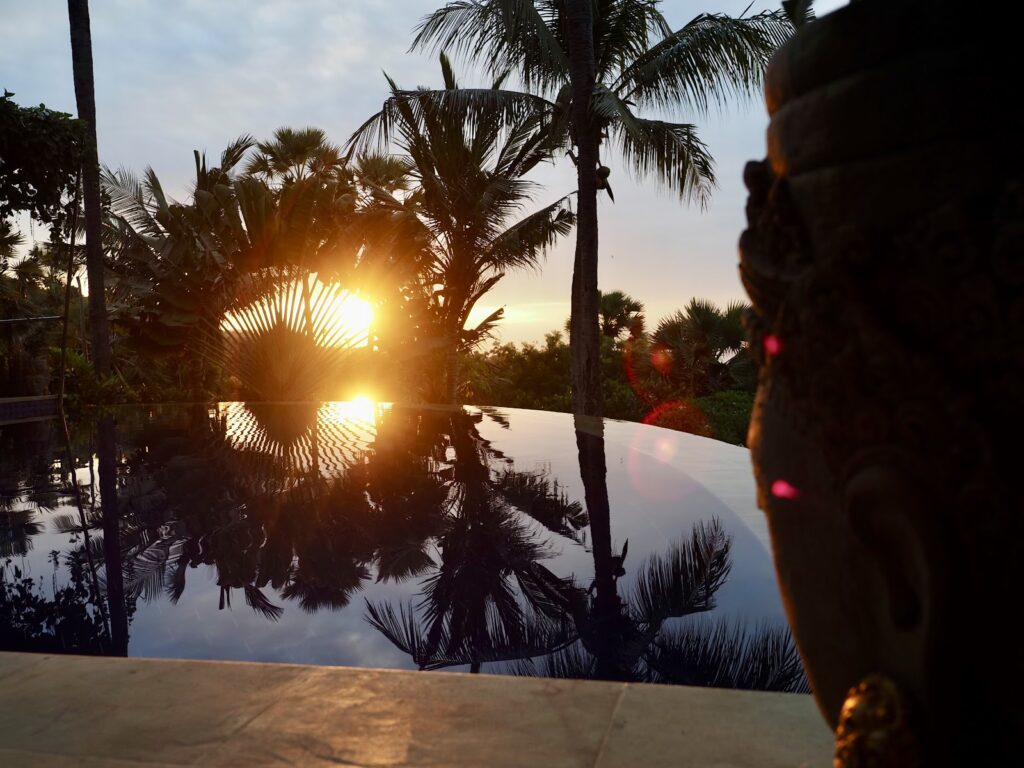
In Bali, online booking apps quickly became our best friend, offering great last-minute deals on surprisingly lavish stays—many with breakfast included, plus extras like swimming pools, beautiful views, and, of course, blessed air-con. We could usually book the same day or just a few days ahead.
Even during peak tourist season, the island seemed to have more rooms than visitors. Rarely did we miss out on our preferred choice, and we could often extend our stays on the spot. Hotels and restaurants alike were seldom full or overcrowded, which gave our trip an unexpected ease.
💡Top Tip: We packed a lightweight, compact mosquito net that quickly proved its worth. Protecting ourselves not only from itchy bights, but also potential mosquito-borne illnesses was essential for a good (and carefree) night’s sleep— especially since many places didn’t provide nets.
Bali Budget Breakdown
💰Total average cost per month: 1.020€ (per person)
We’d always assumed that once we reached Southeast Asia, our expenses would drop dramatically. We pictured saving heaps of money and maybe even travelling indefinitely. Bali quickly proved us wrong—though we do think it’s something of an exception in the region. Its popularity with tourists inevitably pushes prices higher.
👉 Important detail: €200 each went toward our freediving courses and certificates, and that’s included in the total. Without it, our actual monthly spending in Bali was about €820 per person—of which 23% went to Tourism/Entertainment.
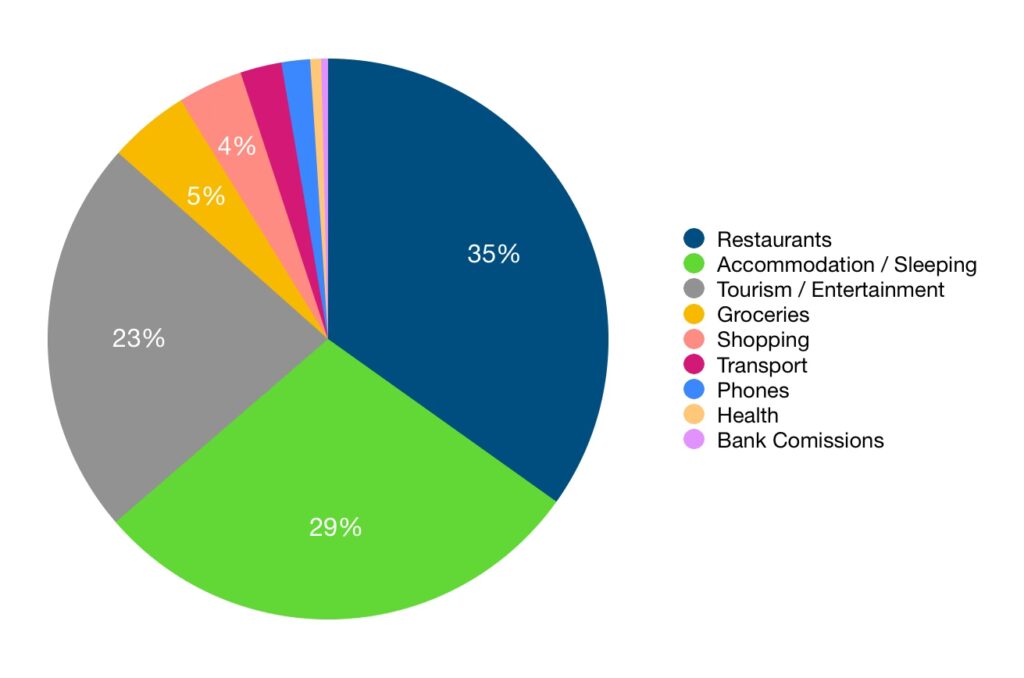
One downside of losing our autonomy (no camping, no cooking) was that we had no choice but to pay for restaurants and accommodation daily. While still far cheaper than New Zealand or Australia, eating out three times a day and sleeping in homestays or hotels every night added up.
The upside? Being a couple really pays off for accommodation. Single private rooms are rare—if not impossible to find—so the cost for the two of us was essentially the same as what a solo traveller would pay.
Food & Drink
In a nutshell: Nasi Goreng and beyond
When it came to food, Indonesia quickly made things interesting. We arrived with little knowledge of the local cuisine but wide-open eyes and mouths, ready to taste as many new flavors as possible.
The unofficial national dish here is Nasi Goreng: fried rice flavored with sweet soy sauce (kecap manis), topped with a fried egg, and served with cucumber slices and starchy crackers (krupuk). It became our early culinary “safe place,” but we knew that eating it three times a day wouldn’t keep us happy for long. We eased in cautiously, mindful of the infamous Bali Belly and other food-borne illnesses travelers love to warn you about.
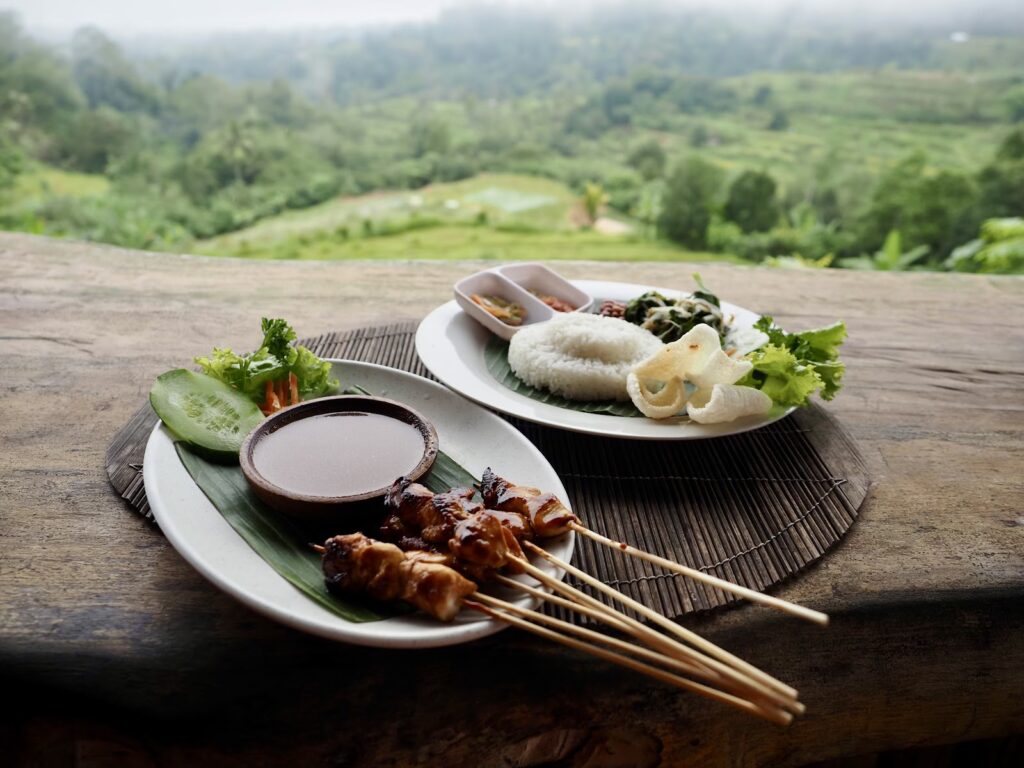
Breakfast required the quickest adjustment. Gone were the days of popping into a supermarket for our usual staples. Instead, we were at the mercy of our homestays or local cafés—where, more often than not, breakfast meant fried rice or fried noodles.
Soon we began venturing further, discovering new dishes we didn’t regret (most of the time). Rice was almost always the star of the plate, with fried noodles as the main alternative—though these were often just packaged instant noodles dressed up with extras.
We tried everything from local curries to grilled fish, from fiery sambal pastes to fragrant herbs and spices: lemongrass, ginger, coconut oil, chili, kaffir lime, sweet soy sauce, and other flavor-boosters unfamiliar to our European palates.
A few favorites emerged—though, as always, the magic depends on where you eat them:
Pepes Ikan — Fish grilled in banana leaves, marinated in a fragrant spice paste
Perkedel — Sweet corn fritters
Sambal Embe — Balinese fried shallot sambal (chili paste)
Kare Sayur — Balinese vegetable curry
When it came to coffee and tea, we had to scramble for new options. Our days of knocking back Barry’s Tea with a dash of milk were officially over. Conor, a devoted espresso drinker, began hunting for good coffee in Bali. Some cafés delivered beautifully—serving locally sourced volcanic beans with rich, complex flavours. Others offered “Balinese Coffee” (Bali Kopi), essentially a big cup of disappointing brown sludge.
We also saw many places serving Luwak coffee — a local specialty made from coffee beans that have passed through the digestive system of civet cats — but given the ethical controversy around animal treatment, we decided not to try it.
Alina, a non-coffee drinker, was pleasantly surprised that Matcha here was not only of high quality but also widely available, so she happily explored the world of green matcha delights on a regular basis.
Route Planning & Navigation
If you take a closer look at a detailed map of Bali, you’ll notice most roads run vertically—from north to south—with very few horizontal routes crossing the island. At first, this felt limiting and confusing to us. It also kept us from venturing further west since that would have meant cycling the entire loop on the main road, which we feared would have too much traffic, especially toward the neighboring island of Java.
Instead, we settled on a modest loop: climbing all the way up Mount Bratan and then following the northern coast eastward. Our only definite waypoint was Amed—the easternmost point on the map below—where we planned to take our freediving courses.
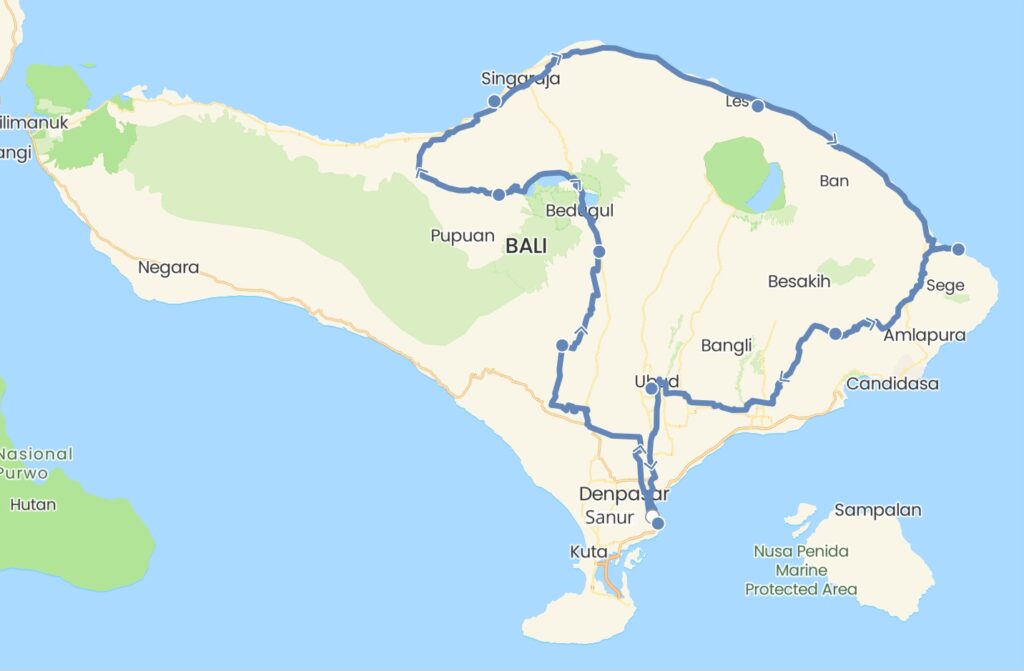
The road layout made navigation fairly simple: either head straight up or down, or follow the coastline.
Some stretches were a real joy—the luxury of winding down smaller backroads through rice paddies felt truly magical, especially on an island otherwise bustling with traffic.
That said, it was a fine balance between stress-free exploration and constantly stopping to check the map. Missing a turn could mean retracing a long way since few roads cut across horizontally—so missing that one crucial crossing could add hours to the journey.
Riding through the rice fields also meant tackling what we dubbed the “Devil Dips”—sudden, incredibly steep drops in the road followed immediately by sharp climbs.
⚠️ Cycling Safety in Bali
At first, we were pretty apprehensive about cycling here. To us Westerners, the roads looked like chaos, with scooters buzzing all around. But surprisingly, this turned out to be the safest we’d felt on the road in a long time.
The apparent mayhem actually works in your favor—the locals are incredibly nimble and skilled at dodging obstacles. Two-wheelers dominate the streets (mostly motorized), and larger vehicles tend to be smaller and move slowly.
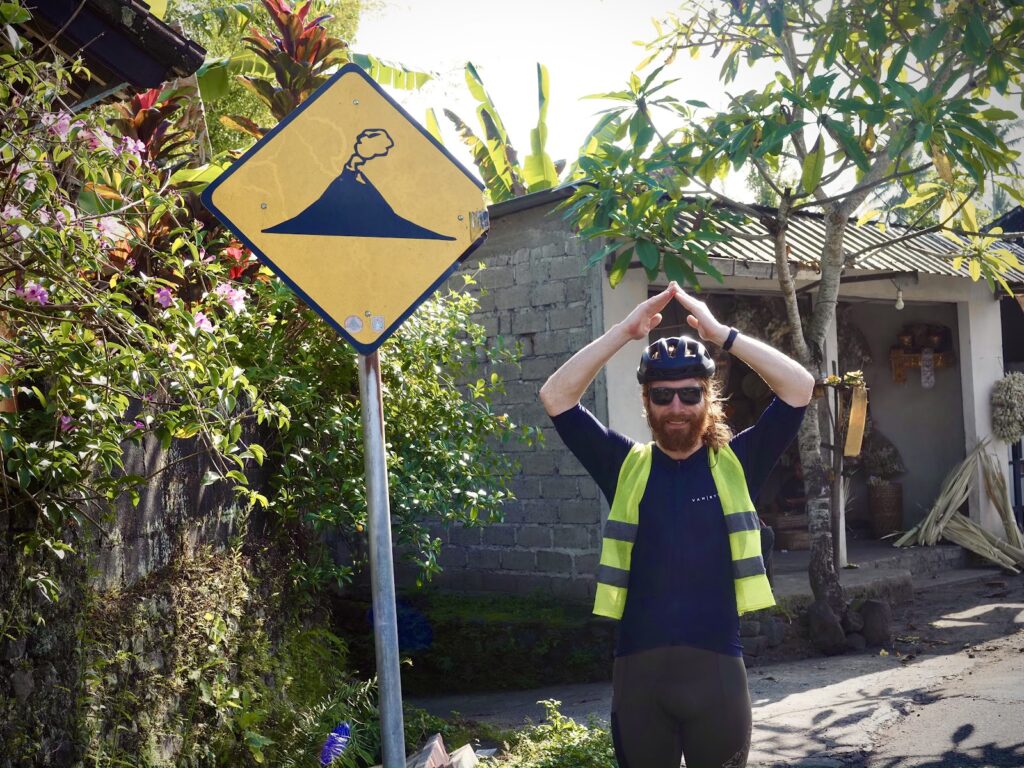
While not an immediate physical danger, one unpleasant and likely harmful downside is the exhaust fumes. They were relentless, especially when climbing steep slopes. Imagine struggling up a criminally steep hill—10 to 12% incline—in hot, humid weather, with endless traffic passing by, scooters, cars, and trucks choking the air with thick, black clouds of exhaust. These are the kinds of emissions that would surely be banned in many European cities today.
We found no easy solution—wearing face masks while pushing up those inclines in the heat just wasn’t feasible.
Final Thoughts
Bali is a nice island and we see the appeal of it, but we would not go back anytime soon, and we would hesitate to recommend it to anyone, bike tourists or otherwise.


